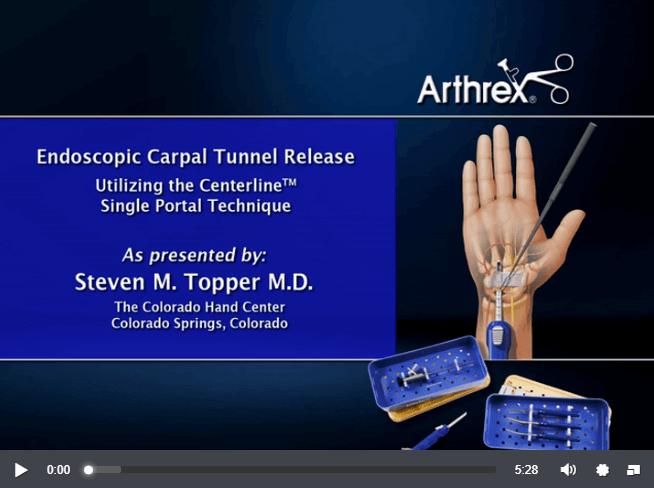Carpal Tunnel Syndrome
Carpal Tunnel
Specialist
Dr James McLean is a hand and wrist orthopaedic surgeon in Adelaide skilled in open and endoscopic carpal tunnel release surgery. His approach for optimal outcomes will help you decide on the best carpal tunnel treatment option for you.

What is Carpal Tunnel Syndrome
Carpal Tunnel Syndrome is a common, painful, progressive condition that is caused by compression of the median nerve at the wrist area.
Carpal Tunnel Syndrome is not a single condition. Rather, it is a collection of symptoms commonly caused by other underlying conditions. In simple terms, swelling inside the narrow carpal tunnel in the wrist is the cause of the pain. A variety of conditions contribute to carpal tunnel syndrome, so your doctor will usually look for underlying causes.
The Carpal Tunnel is a narrow passageway between the wrist and the hand. The wrist bones lie underneath it, and the transverse carpal ligament sits over the top. Inside the carpal tunnel is the median nerve, which gives feeling to the thumb, index finger, third finger and half of the ring finger. Several tendons also pass through this narrow space. When swelling occurs, these tendons squash or constrict the large median nerve. Symptoms of numbness, pain and reduced function are the result.
Symptoms of
Carpal Tunnel Syndrome
If you have any of the following symptoms of Carpal Tunnel Syndrome, it's a good idea to make an appointment.
Early intervention often means treatment is more effective.
- Weakness in your hand
- You suffer pain at night.
- Diminished grip strength
- You have pain that radiates into your arm or shoulder.
- Your little finger and half of your ring finger are not affected by pain or weakness.
- You have stabbing pain in your wrist.
- You experience numbness or pins and needles in your wrist or hand.
- Tingling sensation in all the fingers except the little finger

Causes of Carpal Tunnel Syndrome
While sometimes the cause of Carpal Tunnel Syndrome remains a mystery, the following conditions are common causes:
- Pregnancy can cause fluid retention which leads to swelling.
- Arthritis often causes swelling and inflammation.
- Wrist fracture, when a fragment of bone irritates surrounding tissue
- Overuse of the hand or wrist, especially when using awkward or repetitive movements. Common examples of this include typing, smartphone use, gaming, e-sports, etc.
- Some people were born with a smaller carpal tunnel, making them more prone to problems.
- Sprains
- Hormonal imbalance, and other medical conditions such as hypothyroidism, rheumatoid arthritis, diabetes, obesity, gout, and overactive pituitary gland
- Presence of a cyst or tumour in the canal
Carpal Tunnel Syndrome Diagnosis
Diagnosing carpal tunnel syndrome involves a clinical evaluation and diagnostic testing.
Dr McLean will assess your symptoms, identify any risk factors, and perform a physical examination which may involve tapping the median nerve and flexing your wrist. If necessary, Dr McLean will use diagnostic testing such as an ultrasound or MRI scan to confirm a carpal tunnel diagnosis.
Non-Surgical Treatments For Carpal Tunnel Syndrome
In most cases, non-surgical treatments will be recommended before considering surgery.
Non-surgical treatment for carpal tunnel syndrome includes:
- Wearing a splint at night to help with the pain
- Resting your hand and wrist if the injury is caused by overuse
- Physiotherapy treatments
- Corticosteroid injections to reduce the swelling
- Diuretic medication which reduces fluid in your body by excreting it as urine
- Treating underlying medical conditions
- Immobilisation of the hand and wrist with a splint or wrist brace for 4-6 weeks
- Ice packs to avoid swelling
- Avoid activities that tend to worsen the symptoms
- Medications such as nonsteroidal anti-inflammatory drugs and diuretics
- Strengthening and stretching exercises once symptoms diminish
If conservative treatment options fail to resolve the condition, your surgeon may recommend a surgical procedure.
Carpal Tunnel Surgery and Recovery
When surgical treatment for carpal tunnel is the best option, Dr McLean will perform a relatively simple operation.
It involves cutting the transverse carpal ligament over the top of the carpal tunnel, which relieves pressure on the median nerve below. As your body heals the injury to the ligament, scar tissue forms which should prevent the buildup of pressure on the nerve.
Dr McLean prefers to manage carpal tunnel syndrome using a minimally-invasive, key-hole endoscopic surgical technique (when indicated). An open technique can also be used and involves a slightly larger incision and clear visualisation of the structures inside the carpal tunnel.
Types of Carpal Tunnel Surgery
Endoscopic Carpal Tunnel Release Surgery (Key-Hole Surgery)
With endoscopic carpal tunnel release surgery, a small cut (10mm) is made in the wrist, and a tiny camera is guided through a thin tube into the hand. This allows Dr McLean to investigate the mechanics of the hand and cut the transverse carpal ligament with minimal scarring. This relieves the pressure on the median nerve to alleviate symptoms of carpal tunnel syndrome.
Open release
This involves a 30mm incision in the palm area, which allows Dr McLean to visualise the contents of the carpal tunnel as well as carefully cut the transverse carpal ligament. This relieves the pressure on the median nerve to alleviate symptoms of carpal tunnel syndrome and allows visualisation and attention to any coexisting problems (such as ganglions or inflammation) at the same time.
The type of surgery you have may influence your recovery time. Each type of carpal tunnel syndrome surgery has its merits and risks. Dr McLean can make a recommendation after consideration of all the factors relating to your condition.
Carpal Tunnel Surgery Recovery
Immediately after carpal tunnel surgery, you may feel some numbness in your hand and fingers.
This is due to the lasting effects of local anaesthesia. As it wears off, you may feel some stiffness and soreness.
You may need to keep your hand elevated and apply ice packs to reduce swelling. This is not the case for all patients. Dr McLean will explain his findings at the time of surgery and recommend whether this is appropriate for you.
If you have open release surgery, you may need a bulky dressing for 2-3 days afterwards. This is normally removed and the non-absorbable stitches will be covered by a dressing that will be removed at your 2-week follow-up after your operation.
Flying After Carpal Tunnel SurgeryGetting home after FIFO surgery Generally you will need to wait 24 hours after your surgery before flying. However, there are a number of factors to consider before booking your flight. Make sure you consider the following: Make an appointment Airline regulations Expand Each airline has its own regulations about flying […]
Read MoreDriving After Carpal Tunnel Surgery It is likely you will not be able to drive for 1 to 2 weeks after surgery. This is because you may experience some sensitivity or pain in the first weeks, which can hinder your ability to safely drive a car. It is sensible to wait until your wound has […]
Read MoreOnce you have a referral…
Book your consultation here.


